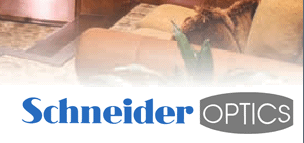





 |
 |
 |
 |
 |
 |
|
Anamorphic lenses are used to create Wide Screen Films. Widescreen films are made several ways but anamorphic widescreen is the best alternative those film makers who do not want to move to some exotic format sized medium or who do not want to waste resolution by cropping of the top and bottom of their image making a letterbox wide screen.. Put simply an anamorphic lens can squeeze a wide image to fit onto a typical format like 4:3 mini-DV cameras. Then when played back the image will need to be stretched out to it's correct width. Anamorphic widescreen can be used with any camera or any projector. And in the case of TV or computer monitor play back the image can be stretched out during editing to create that letterbox look everyone is familiar with.
Then upon projection an anamorphic lens is used to expand the image by 2x, so as to render the extra wide natural looking image. When the image is captured with a digital video camera the digital image must be expanded by 2x to render the image properly. This can be done using an anamorphic lens in front of a video projector or using editing software if the image is to be shown on a TV or a computer screen. Note that this process expands the image horizontally unlike letter boxing which removes the top and bottom of image reducing it's size horizontally. The anamorphic system was designed to be a more expansive, grander image projection system. Not all anamorphic lenses are 2X. Another popular format is the 1.5X anamorphic lens. When this lens is used in conjunction with a medium that has a native format of 1.33:1 the final stretched image is very close to the 2:1 format. And if a 1.33X anamorphic lens is used with the 1.33 format the resulting stretched image will be very close to the popular 16:9. A cheap and easy way to get experience using an anamorphic lens is to use readily available anamorphic projector lenses. Though these lenses were not designed to be used for cameras they can none the less be easily modified to be used with a camera. These projector lenses have the same basic abilities as the original Cinemascope lenses. However, they do not have the sophisticated design of modern Panavision anamorphic lenses which yield a shaper image with less anamorphic distortion and focus issues typical of the old Cinemascope process. When using a anamorphic lens adapter you change the overall focal length of the lens system as a whole of the horizontal plane by increasing the field of view by 2X. That is if you place a 2X anamorphic adapter in front of a 50 mm prime lens the whole lens system has a horizontal focal length of 25 mm. This means that your anamorphic lens system has two focal distances, one for the vertical and one for the horizontal. If the iris is sufficiently open and the depth of field for the two focal distances are each so narrow that they do not overlap there will be no way to focus the anamorphic system. The idea is to increase the depth of field for each of the focal lengths so that they overlap. This overlap of the acceptable focal fields is the anamorphic system's "sweet spot of focus." However, prime lenses designed to be used with anamorphic adapters are hyper focal lenses. That is they have a fixed focus where everything at that focal distances and further is in focus. A narrow depth of field gives a cinematographer the ability to use selectable
focus. Selectable focus is a photography too that is closely associated
with the "real" film look and can be a great tool for transitions, and
focusing the audiences attention. But when trying to focus a simple anamorphic
lens the camera's iris will need to be closed down substantially to focus
both the horizontal and the vertical image planes. This will create a
large or even infinite focus field depth but that's the price for affordable
wide screen. Check out the old Cinemascope prints from the 50s and 60s,
everything is in focus, because of a very wide fields of focus depth.
Modern anamorphic camera lenses have special design features that overcome the old focus problems. But, unless you have really good modern design anamorphic lenses for camera your focus is going to be soft, or worse, you may get double imaging. Also, when you stretch your image in post your pixels will have a virtual widening of a factor of two. This creates an effect that is very soft, but not out of focus, and has a "filmick" quality all its own. So what you loose in a narrow depth of field you make up for using an anamorphic lens. The focal ring on the anamorphic projector lenses really has little to do with focus at all. In fact it is used to set the anamorphic magnification. The anamorphic system suffers from having different amounts of anamorphic magnification at different distances in front of the lens, more magnification, closer in, and less, further out. To remedy this there is a ring to change the level of magnification so that it will be 2X at any given distance. This ring should be adjust in tandem with focus to give proper anamorphic magnification at all focal lengths. Projecting anamorphic films: If you create and edit your super 8 mm anamorphic project the old fashioned way, and project right from the film, then you have the opportunity to demonstrate the "real" WIDE SCREEN experience. After you have edited the film you shot with your camera, using the anamorphic lens, and your film is ready for projection, simply mount the anamorphic lens in front of the projector. The lens should be oriented the same way it is as when it is on the camera. The lens will stretch the projected image twice as wide as normal projection. You will need a screen that is twice as wide or you will need to move you projector to half of the distance away from the screen, or some combination of the two. Stretching an anamorphic image on a nonlinear digital editing system is fun and it does yield the wide screen, though it is not as impressive as projecting an anamorphic image from the actual film. If you have the means, this is a great super 8 mm project.
|
||||||||
| For more information, please visit www.cinemaexperience.com or phone 01707 695 283 (Office hours 9am to 6pm) | ||||||||